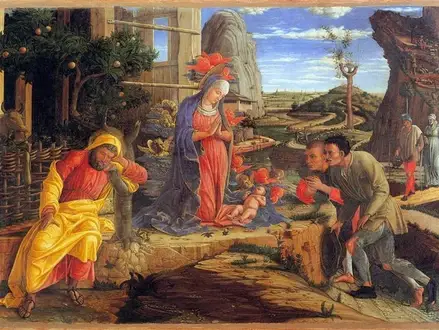Title of Artwork: “Adoration of the Shepherds”

Artwork by Andrea Mantegna
Year Created 1456
Summary of Adoration of the Shepherds
An Andrea Mantegna painting called the Adoration of the Shepherds is thought to have been done around 1450 or 1451.
This small painting is usually thought to have been done when Mantegna was young. Borso d’Este, who lived in Ferrara in 1450–1451, may have asked the artist to make this painting while he was there.
All About Adoration of the Shepherds
Before moving the work to canvas at an unknown time, the piece was on panel. A small section of the right side was cut off. An inventory of Margherita Gonzaga d’Este’s things from 1586 may have included this book. It may have been referred to as a “Prosepio de Andrea Mantegna” (“Nativity Scene of Andrea Mantegna”). Cardinal Pietro Aldobrandini had it by 1603 and kept it in the Villa Aldobrandini.
Then it went to his family. Soon after that, the Pamphilj and the Borghese took over. For sale in 1792, the painting dealer Alexander Day bought it and took it to London; he then sold it to someone else.
William Buchanan sold it to Richard Payne Knight at Downton Castle, in Herefordshire. His heirs sold it to Joseph Duveen, who bought it from his family. An anonymous donor bought the painting for the Metropolitan Museum of Art in 1925. It came from Duveen, New York.
When the scene opens up, there is a wide open space with Mary in the middle, kneeling on a stone step, and the Child in front of her. To her right, St. Joseph is sleeping, and to her left, two shepherds are praying.
St. Joseph’s sleep may show that he is only there to protect the Virgin and the Child. In the old days, people thought that the tree on which he leans had fruit on just one branch; now, they think it means that nature is reborn in the new world. Jesus is shown in three-quarters in Mantegna’s work.
There is a fenced-in orchard on the far left to show Mary’s virginity. Also shown are the boards from the stable where Jesus is said to have been born in a ruined state. On the right, there is a wide open field, framed by two steep mountains.
Other shepherds and a big tree that looks like the Calvary Cross are shown in the right background. This is a sign that Jesus will be killed. There is also an ox, which is a traditional mute witness to the birth of Jesus at the time of his birth.
Scholars think this work was done around the same time as some of the first frescoes by Mantegna in the Ovetari Chapel, like the first scenes of the Life of St. James. There are some problems with the perspective (1448-1450).
Flemish School: Mantegna could study Rogier van der Weyden’s work in the Este family’s art collection, or he may have known him through a friend. There are many details in the grotesque portrait of the shepherds that show that they were inspired by examples from northern Europe.
Information Citations
En.wikipedia.org, https://en.wikipedia.org/.






















